Contact for the resource
Federal Institute for Geosciences and Natural Resources
79 record(s)
Provided by
Type of resources
Available actions
Topics
Keywords
Contact for the resource
Service types
-
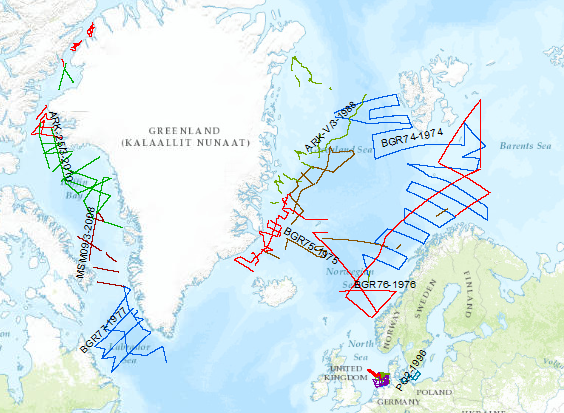
During the period from 1974 to 2018 various cruises from BGR acquired seismic lines worldwide. The aim of these marine expeditions was a detailed survey of the geological structure.
-

The area of the 1st leg of METEOR cruise no. 67 lies off the Moroccan coast between longitudes 32.5°N and 35°N and latitude 12°W. Within this continental margin segment multichannel reflection seismic measurements were carried out in parallel with magnetic and gravimetric measurements on 22 lines with a total length of 4,378 km during the period from January 20th to February 13th 1984, with the research objectives: i) to collect new geophysical data for a better understanding of magmatic-volcanic and tectonic processes during the initial drifting phase, and ii) to search for suitable positions for deep drilling sites of the "Ocean Drilling Programme" in the transition zone between continental and oceanic crust. A distinct and sharp reflection seismic boundary running from about 31°30'N/11°W in the south to 34°30'N/10°25'W in the north separates flat-lying Mesozoic sediments overlying slightly structured basement of the Jurassic "Magnetic Quiet Zone" from the complex Moroccan piercement zone in the east. A prominent magnetic anomaly, called S1, is nearly coincident with the sharp reflection seismic boundary, and is thought to represent most probably the initial drifting zone. The Moroccan piercement zone is interpreted to represent the eastern part of a pre-Jurassic rift-basin which conjugated western part lies off Nova Scotia/Canada. Subsidence associated with small-scale rotational block-faulting was time-transgressive in the Moroccan piercement zone, e.g. it started in Triassic time in the central part of the rift-basin and affected successively its landward parts apparently due to successively cooling of the stretched and thinned crust. Weak magnetic anomalies trending approximately NE-SW were recorded within the Jurassic "Magnetic Quiet Zone" lying west of magnetic anomaly S1. These anomalies can be correlated over distances of up to 300 km. They are interpreted to represent either variations of the geomagnetic field intensity or field reversals during a time of weak geomagnetic field.
-
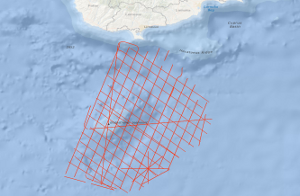
The initial study area of the cruise MSM14/2 GeoNORM (Geophysik im noerdlichen Roten Meer) was the northern Red Sea. However, because of not given research permissions from Egypt and Saudi Arabia, the study area had to be changed to the alternative study area Eratosthenes Seamount (ESM), south of Cyprus. The ESM is supposed to represent a continental fragment of the former African-Arabian Plate that is entering the subduction zone south of Cyprus i.e. the subduction turns into collision in the area of the ESM. This changed the entire tectonic setting in the Eastern Mediterranean. Therefore, the tectonic evolution of the area is rather complex with phases of extension, subduction, compression, salt tectonics and gravitational processes and not comprehensively understood. Because of the isolation of the ESM as a continental fragment this region is an ideal spot to investigate the transition from regular subduction to continental collision and its associated tectonic processes i.e. faults were activated or reactivated, transform motion has to be compensated, the overriding plate has been elevated. This impacts the ongoing geological and tectonic processes in this region but also influences the social and economic life in the Eastern Mediterranean as earthquakes and submarine landslides are possible geohazards and the entering of the ESM to the subduction trench alters the thermal history of the adjacent sedimentary basins significantly what should have an influence on the maturity processes within the source rock sediments and new faults open new migration paths for hydrocarbon fluids or gases.
-
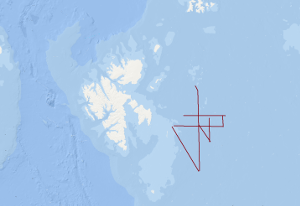
The PANORAMA-2 research cruise was carried out between August 15th and September 20th 2015 aboard the Italian research vessel OGS Explora, like the PANORAMA-1 cruise in 2013. The intended survey area was the European sector of the Arctic east and southeast of the Svalbard archipelago in the area of the northern Barents Sea. Main target of the PANORAMA-2 cruise was the acquisition of new geophysical data and the probing of surficial sediments in the underexplored area of the Sørkapp Basin and Olga Basin. In the course of the 20 day lasting Leg1 of the PANORAMA-2 cruise geophysical data acquisition was carried out. About 1750 km of 2D multi-channel seismic data were acquired and about 350 km of wide angle seismic data by means of sonobuoys. Sediment echosounder data, multi-beam data, gravity data and geomagnetic data were acquired during the entire cruise in a 24/7 mode within the survey area. After a 1-day stopover in Longyearbyen for a crew change of a part of the scientific crew, the research vessel OGS Explora returned to the survey area for another 11 days. During Leg-2 of the PANORAMA-2 cruise the surficial sediments were sampled by means of gravity corer, multi corer and dredge at 34 stations all together. Sediment sampling was carried out during day-light times only. Night times were used for acquisition of geomagnetic data, gravity data, sediment echosounder data and multi-beam data.
-

In the frame of the Continental Margin Study Program of the Federal Institute for Geosciences and Natural Resources (BGR, Hannover) marine geophysical measurements (48-channel reflection seismic, sono-buoy refraction, gravity and magnetic) were conducted over the Atlantic continental margin of Canada from 23th July to 7th August 1979 with S.V. EXPLORA (BGR79 leg 2). The survey on the Canadian continental margin was planned in cooperation between the Federal Institute for Geosciences and Natural Resources (BGR) and the Atlantic Geoscience Centre of the Geological Survey of Canada (Bedford Institute of Oceanography, Dartmonth, N.S.) on the base of existing Canadian multichannel seismic lines. A main target of the cruise was to acquire data which allow a comparison of the deep sedimentary basins offshore Nova Scotia with the already known basins offshore Morocco. The eastern part of the survey imaged complex structural deformation due to salt diapirs. The western seismic lines allowed to investigate the structural relationship between the Scotian Basin and the Georges Bank.
-
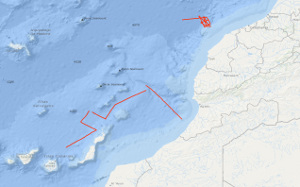
In the period from February 13th to March 2nd 1980 4,037 km of magnetic, gravity and bathymetric lines and 1,195 km of digital reflection seismic lines were recovered on the 2nd leg of METEOR cruise no. 53. Heat flow measurements have been performed on 13 stations; on two stations sonobuoy refraction measurements and dredging have been carried out. From a preliminary interpretation of the seismic monitor records the Mazagan Plateau is part of the Moroccan Meseta. Seawards of this stable swell lies the 75 km wide, downfaulted rift graben characterized by salt diapirs. A submarine body, 150 square kilometres large, lying at the foot of the Mazagan Escarpment in water depths of 3000 m - 3800 m beneath sea level, from which western flank few granitic fragments were retrieved, is interpreted as a subsided and tilted block of the Mazagan Plateau. The north-trending magnetic anomalies, discovered during METEOR cruise no. 46 within the Essaouira continental margin segment have also been recognized within the Tafelney Plateau segment, situated between latitudes 30°45'N and 31°30'N off Morocco. Two neo-volcanic zones were found west of the Conception Bank and west of the Betancuria Massif/Fuerteventura Is. The Mesozoic and Tertiary depositional sequences are highly deformed by small piercement structures interpreted as dykes within these zones.
-

The multidisciplinary marine geoscientific expedition ARK-25/3 was focused on the Greenland part of northern Baffin Bay and was aimed to acquire new geoscientific data to be used for modelling the evolution of the Greenland continental margin and its hydrocarbon prospective. The data format is Society of Exploration Geophysicists SEG Y. The cruise was performed under the direction of the Federal Institute for Geosciences and Natural Resources Hannover in cooperation with the Alfred-Wegener-Institute for Polar and Marine Research, Bremerhaven. Using 70 days of ship time onboard the research icebreaker R/V POLARSTERN a comprehensive data set was acquired along profiles extending from the deep oceanic basin in the central part of North Baffin Bay onto the Greenland continental margin in an area which was bordered by the Kane Basin in the North and Disko Island in the South. By means of multi-channel seismic, wide angle seismic, gravimetric and magnetic methods the structural inventory of the crust in the NW Baffin Bay was investigated. Additionally, heat flow data and sediment cores were collected along lines crossing the Greenland continental margin. The cores were extracted for geochemical and geomicrobiological analysis to be used for basin modelling, studying the hydrocarbon potential, and the hydrocarbon degradation by microorganisms under polar conditions. Geological sampling in the coastal area was done between Melville Bay and Washington Land. The collected rock material will be used to derive constraints on the erosion history of the coastal area. Aeromagnetic data was acquired covering a substantial part of the marine survey area to investigate magnetic signatures of the oceanic crust and the continental margin. This report summarizes the working programme and contains the documentation of acquired data and first results of the expedition.
-
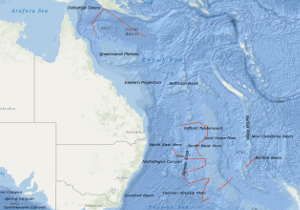
In the period from October 16, 1978 to December 9, 1978 geophysical investigations have been carried out on SONNE cruises SO-7A and SO-7B on the Lord Howe Rise off eastern Australia and in the northern Coral Sea by the Federal Institute for Geosciences and Natural Resources (Hannover) in co-operation with the Bureau of Mineral Resources, Geology & Geophysics (Canberra), Department of Scientific and Industrial Research (Wellington), Geological Survey of Papua New Guinea (Port Moresby). A total of 10,500 km of bathymetric, magnetic and gravity profiles, 7,000 km of digital seismic reflection profiles and 50 sonobuoy refraction profiles were recorded during this survey. Objective of cruise SO-7A was to determine the depth and nature of the basement of the Lord Howe Rise, the configuration of the early rift basin, and the thickness and internal structure of the enclosed sediments. A new sea-mount in the southern Norfolk Basin rising some 2200 m above sea floor characterized by a free air anomaly of about 80 mgal and by a magnetic anomaly of some 500 nT was found. A complex horst and graben zone often associated with volcanic intrusions underlies the western flank of the Lord Howe Rise. Within some grabens the "breakup"-unconformity seems to exist, supporting the model that the Lord Howe Rise and the Dampier Ridge were once part of the Australian continent. The thickness of pre-breakup sediments is normally small on the Lord Howe Rise. Only in some grabens the thickness of these sediments exceeds 1 second reflection time. The Oligocene/Eocene unconformity and a Miocene unconformity are clearly recognizable in all our seismic records. Best explanation of these unconformities seems to be relative falls in sea level due to swelling and subsidences of oceanic crust. Strong variations in the character of the acoustic basement have been observed. Besides blocks with flat-lying acoustic basement zones with hummocky and irregular basement surface exist which may relate to areas of stretched continental basement contaminated by basaltic intrusions. The eastern edge of the Lord Howe Rise is characterized by an edge anomaly rising to +1000 nT. The general magnetic and gravity features of the western flank of Lord Howe Rise and the Dampier Ridge are: A generally quiet magnetic field with isolated large anomalies, consistent with the faulted acoustic basement of low or moderate susceptibility, with low susceptibility, dense intrusives in places, and also high susceptibility intrusions or flows. Gravimetric/magnetic "edge anomalies" between the outer and western edge of the Lord Howe/Dampier Ridge and the Tasman Sea are apparently absent. The objective of cruise SO-7B was to search for marginal graben zones off the Queensland and Papuan Plateaus associated with the initial rifting of the Coral Sea Basin. In the seismic records at least two regional unconformities are recognizable which represent periods of erosion or non-deposition during Oligocene/Eocene respectively in Miocene time. Further an older unconformity exists in block-faulted regions of the Queensland and Papuan Plateaus. Beneath the present continental slopes the Miocene and Oligocene/Eocene unconformities lie close together and are sometimes coincident. The transition from oceanic crust of the Coral Sea Basin to continental crust of the Queensland and Papuan Plateaus occurs in the surveyed area over a narrow ( 50 km) zone and is associated with a sediment filled graben. The graben-zone observed beneath the present slope of the Queensland and Papuan Plateaus contains more than 2 sec (reflection time) thick sediments of pre-Oligocene/Eocene age. The oceanic crust, as it approaches the plateaus, either rapidly deepens or abruptly stops and/or changes its seismic character so as not to be recognizable. In the seismic records from the outer part and slope of the Queensland and Papuan Plateaus, 5 to 10 km wide, convex, reflectionless zones exist. These features are interpreted as drowned fossil reefs. All observed reefs lie beneath the Oligocene/Eocene unconformity indicating these present deep-water areas were at shallow depths in pre-Eocene time. In the surveyed area post-Oligocene fossil reefs do not exist suggesting these areas were already at upper bathyal depths in the Oligocene. Assuming a seismic velocity for reefal material of 4000 m/s, the reefs on the outer Papuan Plateau have an approximate thickness of 3000 meters. Assuming a reef-growth rate of 25 m/m.y. the growth of the reefs started in upper Jurassic time (120 m.y. + 29 m.y. (assumed age of the Oligocene/Eocene unconformity) yields to 149 m.y.). The basement of the Papuan and Queensland Plateaus is probably crystalline Paleozoic rocks. This is suggested for the Queensland Plateau in particular by their relatively shallow depth, refraction velocities of 6.0 - 6.3 km/s (Ewing et al.) and 5.0 (this survey) and high intensity magnetics. A complex system of horst and graben structures exist on the Queensland and Papuan Plateaus. A larger graben appears to trend in an East-West direction on the southern Papuan Plateau. This graben is about 1 second (reflection time) deep and varies in width from 5 to 20 km.
-
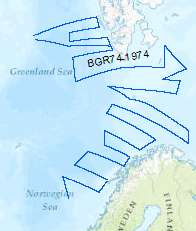
Reconnaissance surveys were carried out in 1974 within the framework of the BGR program "Geoscientific studies in the North Atlantic". The areas covered were the continental margin of Spitsbergen, the Barents Sea and the Norwegian continental margin. On the R/V LONGVA (10th August, 1974 - 10th September, 1974) multichannel seismic measurements were carried out on 40 lines with a total length of 8,091 km. The data format is Society of Exploration Geophysicists SEG Y.
-
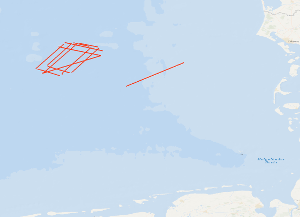
The cruise AL278 started on May, 10th 2006 in Kiel and ended in Kiel on May, 19th 2006. The previous BGR-cruises with RV AURELIA in 2003 and 2004 were designed to collect a grid of seismic MCS-data which should enable us to get a high-resolution overview over the upper 1 s TWT of the sediments of the German North Sea sector. During October/November 2005 a subsequent cruises with RV HEINCKE and FK SENCKENBERG was designed to tackle several special aims: - The detailed mapping of glacio-tectonic features North of Heligoland. - The shallow seismic mapping of the Holocene/Pleistocene-Boundary and topography of the Pleistocene sub-glacial valley system offshore of the East Friesian Islands. - High-resolution surveying of two areas designated for offshore wind farms in the southwestern German sector. - Detailed mapping of a wide and deep sub-glacial valley. One additional aim was to acquire a dense grid of seismic line in the area North of Weisse Bank where on several from previous cruises indications for shallow gas accumulations (e.g. “bright spots”) were found. Unfortunately, due to very bad weather conditions this aim could not be reached. Therefore this short cruise with RV ALKOR was used to acquire twelve MCS lines over this area. During the cruise a total ca. 1400 km of high quality MCS lines were surveyed and simultaneously measured by a sediment echosounder system that enabled additional profiles during transits with speeds 5 kn. Together with the previously acquired data these new data should help to extend our knowledge of the Late Tertiary and Quaternary evolution of the German North Sea Sector. The BGR high-resolution multichannel seismic reflection system consisting of a GI-Gun (0.8 l) and a 300 m streamer with 24 channels and a sediment echosounder type SES 2000 standard by Innomar, Rostock. While the BGR-seismic system was used to observe the shallow subsurface down to 2 s TWT penetration depth, the sediment echosounder with a penetration depth of several meters was primarily intended to identify sampling positions for the deployment of the BGR vibration corer during the succeeding Leg 2. Additionally, the echosounder system enables the relationship to the highest-resolution multichannel seismic measurements of the group of the University of Bremen on FK SENCKENBERG. All seismic records were processed onboard for the quality control and for a first interpretation.
 www.geodatenkatalog.de (S3L)
www.geodatenkatalog.de (S3L)